What can be made of plastic pipes: actual crafts that can be
In this article we will talk about what homemade plastic pipes can be collected independently. Indeed, after the construction of the sewerage, water supply or heating system is completed, a large amount of unnecessary materials remain for which, by the way, money from the family budget was paid not so long ago.
It is most likely that it will not be possible to use unnecessary pipe cuts for its intended purpose, since the finished plumbing system has already been built. Again, and the store will not be able to return the excess. But if you connect the imagination to the seemingly unnecessary remnants of the pipeline, it will be easy to find an application.
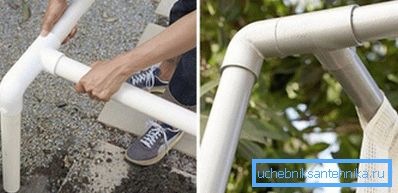
What is required for working with plastic pipes

The instruction for processing and assembling structures using plastic pipes involves the use of the following tool:
- special cutter, cutting at a right angle, if necessary, you can use a hacksaw for metal;
- soldering iron for polypropylene pipes, in extreme cases, an acetylene torch can be used;
- fitting - connecting elements, which are selected in accordance with the type of pipe.
So, after we have decided on what tools and materials will be required to carry out the planned work, consider the technology of manufacturing various handicrafts.
Making snowshoes
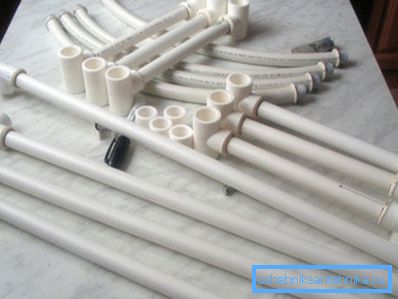
A snowy winter for most of the post-Soviet space is the climatic norm, and therefore accessories for comfortable movement in deep snow are relevant for many compatriots. It is easy to assemble snowshoes with your own hands from plastic pipes, especially since this does not require a special tool.
So, if you are not used to using skis, but you are attracted by walks through a snow-covered forest, it's time to start producing snowshoes. Let's try to make a device for a person of average height with a weight of not more than 70 kg.
For this we need the following materials:
- polypropylene pipe with a diameter of 20 mm - 4.5 m;
- metal-plastic pipe with a diameter of 20 mm - 2 m;
- tees with sizes of 25-20-25 mm - 12 pieces;
- tees with sizes 20-20-20 mm - 4 pcs;
- kegs - 20 mm - 4 pcs;
- laminated plywood (thickness not less than 4 mm);
- semi-rigid ski bindings;
- screws and screws.

Instruction of work is as follows:
- Cut pieces of polypropylene 4 pcs. on 65 cm, and 8 pieces. 23 cm
- 4 pieces of metal are cut into pieces. 50 cm
- Metal-plastic blanks, applying a special spring, bend in a semicircle;
- Using a soldering iron or acetylene torch, we melt the ends of polypropylene blanks and connect them with tees as shown in the photo.
- It remains with the help of the same soldering iron to collect all the blanks into a single structure. On the frame, assembled from pipes, we fasten plywood squares, directly on which you can fix ski bindings.
So, we have reviewed the general assembly instructions for snowshoes, intended for use in winter.
Raft of materials remaining after sewer assembly
Is it possible to do something for use in the warm season? Of course, you can, for example - homemade catamaran from plastic pipes.
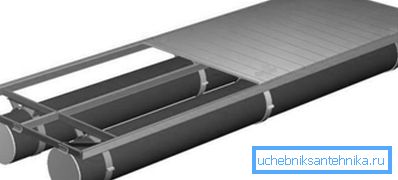
For assembling a catamaran-type raft, you can use polyvinyl chloride (PVC) sewer pipes. The advantage of using these products is the presence of a socket connection and special fittings that can be used to cover the ends.
Note! There are no less durable polyethylene pipes on the market, but such products are difficult to weld at the ends, therefore, we consider an option based on PVC components.
In order for the raft to stay afloat, two floats of the appropriate size will be required. The best choice will be PVC pipes with a diameter of at least 500 mm.
Assembly instructions are as follows:
- a solid frame measuring 6 * 2 meters is assembled from an aluminum corner or from a board;
- pipes are clamped as shown in the figure;
- the design of floats is attached to the frame by bolting;
- sealed plugs are put on the socket ends;
- from the side of the rolled ends, flare couplings and plugs are put on;
- on the frame is the boardwalk.
Important: Assembled in accordance with the instructions catamaran must have fully sealed floats. Therefore, it is necessary to make sure that there are rubber sealing rings at the junction of the pipe and the plug and that water does not seep inside.
Since the instructions for making the raft are already known to us, it remains to take care of the manufacture of fishing gear. Consider how the fabric of the plastic pipe is made.
We make summer zherlitsu
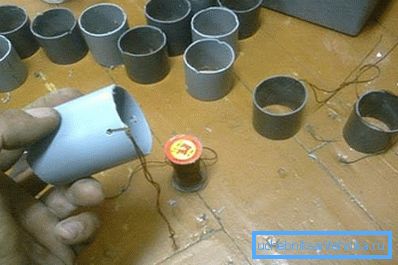
The main disadvantage of many rivers and lakes from the point of view of a fisherman is the presence of coastal bushes and other vegetation. Coastal thickets prevent fishing with the use of spinning, and in this case a mouth stone is used, which is easy to do with your own hands from scraps of plastic pipe.

You can use PVC trimming for a 6 cm long and 5 cm diameter pipe to make a zherlitsa. You can use a large cylinder length, but as practice has shown, these dimensions are most successful because they allow you to wind the required amount of cord or fishing line. There are no special requirements for the colors of the pipes, you can use the most common modifications of white or gray.

Each of the sawn-off cylinders from one of the ends is incised with a hacksaw or drilled with a drill. In order to keep the winding on the prepared cylinders from the bicycle chamber, we cut the rings.
Preparing sledges from the remnants of the plumbing
Finally, I would like to consider the recipe for the manufacture of any vehicle. Of course, it is not possible to assemble the velomobile from plastic pipes, since the strength of this material is not sufficient in order not to deform under the muscular influence of a cyclist on the structure as a whole. But here's a children's sled from tubes even quite obtained.
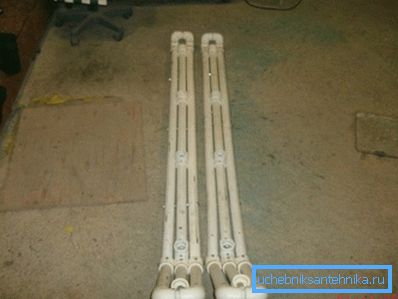
Are the polypropylene parts of the pipeline left? And, of course, they have nowhere to apply, and it is a pity to throw out? Do not rush to throw away unwanted pipes, as you can assemble good sleds from them.
Factory sledge for a child can be purchased with the onset of the season in any supermarket and the price of this purchase will be low. On the other hand, collecting sledges from plastic pipes, you can dispose of waste left after replacing the water supply. In addition, you can get valuable experience with polypropylene, which will probably come in handy later.
We will begin assembly with installation of runners.
For this we need:
- 6 pieces of polypropylene pipe with a length of 1 meter and a diameter of 25 mm;
- 10 corner joints at 45 degrees;
- 12 connections made at right angles;
- 6 tees for mounting the upper part of the sleigh on the runners.
Getting to the assembly runners:
- With one of the ends of the prepared meter tubes, we fix the angle fittings at 45 degrees using a soldering iron.
- On 2 segments, which will be located in the middle of the runners, we fasten 3 tees each with a step of 20 cm from each other, into which props will be inserted.
- Front and back do the bends of the runners, as shown in the photo. All welded joints for greater strength strengthened with screws.
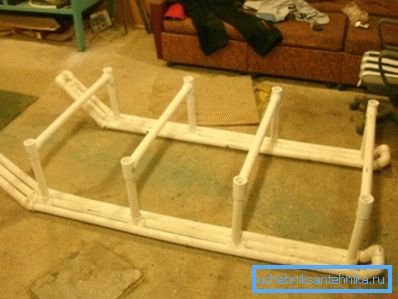
At the next stage of the assembly, it remains to install supports under the boardwalk. We cut props from the same polypropylene pipes.
Important: The size of the supports is determined from the considerations that the lower they are, the stronger the whole structure will turn out.
In the same way as runners, we reinforce props with self-tapping screws. At the final stage of assembly work, runners are sheathed with laminated plywood. The same material can be fixed in the upper part of the assembled sled.
Conclusion
So, we looked at a few examples of how you can apply the remaining pipe after repair. Of course, these methods are much more. It is enough to show a little imagination, and you will be able to come up with how to use seemingly unnecessary construction waste for your home or your dacha.
Have any questions? More useful information you can find by watching the video in this article.